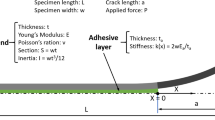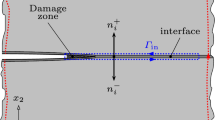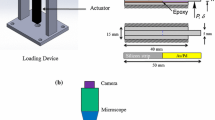Abstract
As well as most polymer materials, adhesives generally exhibit significant viscous behaviour over a wide temperature range. However, strain rate sensitivity, relaxation or creep phenomena are rarely explicitly considered when crack propagation phenomena along adhesively bonded joints are involved. In the present contribution, a detailed analysis of crack propagation along viscoelastic and elasto–viscoplastic interface in a double cantilever beam (DCB) test is proposed. The Nishihara Model is used for modelling the interface separation mechanical response. Assuming self-similar crack propagation regime, a Eulerian representation can be used to simplify the resolution of the constitutive equations which control the stress/strain distribution along the fracture process zone (FPZ) combined with a finite difference resolution technique to evaluate adhesive strain/stress evolution along the bondline. Parametric analysis is then proposed to evaluate the relation between crack propagation conditions and the interface rate-dependent behaviour.
















Similar content being viewed by others
References
Al-Ghamdi AH (2004) Fatigue and creep of adhesively bonded joints. Doctoral Dissertation, Loughborough University
Anderson TL (2005) Fracture mechanics: fundamentals and applications. Taylor & Francis Group, New York
Barla G, Debernardi D, Sterpi D (2012) Time-dependent modeling of tunnels in squeezing conditions. Int J Geomech 12(6):697–710
Blackman BRK, Kinloch AJ, Rodriguez-Sanchez FS, Teo WS (2012) The fracture behaviour of adhesively-bonded composite joints: effects of rate of test and mode of loading. Int J Solids Struct 49(13):1434–1452
Bradley W, Cantwell WJ, Kausch HH (1998) Viscoelastic creep crack growth: a review of fracture mechanical analyses. Mech Time Depend Mater 1:241–268
Broughton WR, Mera RD (1997) Review of durability test methods and standards for assessing long term performance of Adhesive Joints. Technical Report. National Physical Laboratory, Teddington
Budzik M, Jumel J, Imielińska K, Shanahan MER (2009) Accurate and continuous adhesive fracture energy determination using an instrumented wedge test. Int J Adhes Adhes 29(7):694–701
Carreras L, Bak BLV, Jensen SM, Lequesne C, Xiong H, Lindgaard E (2023) Benchmark test for mode I fatigue-driven delamination in GFRP composite laminates: experimental results and simulation with the inter-laminar damage model implemented in SAMCEF. Composites B 253:110529
Dillard DA, Pocius AV (2002) The mechanics of adhesion. In: Adhesion science and engineering—1. Elsevier, Amsterdam
Elmukashfi E, Cocks AC (2017) A theoretical and computational framework for studying creep crack growth. Int J Fract 208(1):145–170
European Cooperation for Space Standardization (ECSS) (2011) Space engineering. In: Adhesive bonding handbook. ECSS Secretariat ESA-ESTEC, Requirements and Standards Division, Noordwijk
Fahimifar A, Karami M, Fahimifar A (2015) Modifications to an elasto–visco-plastic constitutive model for prediction of creep deformation of rock samples. Soils Found 55(6):1364–1371
Fourton P (2019) Dynamic adhesion breaking in laminated glass—effect of interfaces and polymer’s rheology. Chemical Physics [physics.chem-ph]. Université Paris sciences et lettres, France
Gallegos C, Martinez Boza JF (N.D.) Linear viscoelasticity. In: Rheology, vol 1. UNESCO-EOLSS
Holmes DW, Loughran JG, Suehrcke H (2006) Constitutive model for large strain deformation of semicrystalline polymers. Mech Time Depend Mater 10(4):281–313
Jhin G, Azari S, Ameli A, Datla NV, Papini M, Spelt JK (2013) Crack growth rate and crack path in adhesively bonded joints: comparison of creep, fatigue and fracture. Int J Adhes Adhes 46:74–84
Ji SS, Genin GM, Paris PC, Berkel TR, Rubin AM (2004) Polymer/metal interfacial crack growth characterized by C. Int J Fract 129(1):63–73
Jumel J (2017) Crack propagation along interface having randomly fluctuating mechanical properties during DCB test finite difference implementation—evaluation of Gc distribution with effective crack length technique. Composites B 116:253–265
Jumel J, Budzik MK, Salem NB, Shanahan MER (2013) Instrumented end notched flexure-crack propagation and process zone monitoring. Part I: modelling and analysis. Int J Solids Struct 50(2):297–309
Kaminskii AA (1996) Modeling quasistatic fracture at a crack tip in polymers and composites under long-term loading. Int Appl Mech 32(7):493–517
Kanninen MF (1973) An augmented double cantilever beam model for studying crack propagation and arrest. Int J Fract 9:83–92
Knauss WG (1973) On the steady propagation of a crack in a viscoelastic sheet: experiments and analysis. In: Kaush HH, Hassel JA, Jaffee RI (eds) Deformation and fracture of high polymers. Plenum Press, New York
Knauss WG (2015) A review of fracture in viscoelastic materials. Int J Fract 196:99–146
Liechti KM, Knauss WG (1982a) Crack propagation at material interfaces: I. Experimental techniques to determine crack profiles. Exp Mech 22(7):262–269
Liechti KM, Knauss WG (1982b) Crack propagation at material interfaces: II experiments on mode interaction. Exp Mech 22:383–391
Majda P, Skrodzewicz J (2009) A modified creep model of epoxy adhesive at ambient temperature. Int J Adhes Adhes 29(4):396–404
Marquez Costa JP (2021) Characterisation and modeling of interfaces in laminated organic composites at high temperature—application to fire resistance of aeronautical structures. PhD Thesis, Paris Saclay University, France
Marquez Costa JP, Jumel J, Badulescu C, Stamoulis G (2022) Self-similar crack propagation along viscoelastic interface during double cantilever beam test. Mech Time Depend Mater. https://doi.org/10.1007/s11043-022-09559-8
Miannay DP (2001) Time-dependent fracture mechanics. Mechanical engineering series. Springer, New York
Mostovoy S, Ripling EJ (1966) Fracture toughness of an epoxy system. J Appl Polym Sci 10(9):1351–1371
Musto M, Alfano G (2013) A novel rate-dependent cohesive-zone model combining damage and visco-elasticity. Comput Struct 118:126–133
Nicolas A, Jumel J (2016) Double cantilever beam tests on a viscoelastic adhesive: effects of the loading rate. Procedia Struct Integr 2:261–276
Plausinis D, Spelt JK (1995a) Application of a new constant G load-jig to creep crack growth in adhesive joints. Int J Adhes Adhes 15(4):225–232
Plausinis D, Spelt JK (1995b) Designing for time-dependent crack growth in adhesive joints. Int J Adhes Adhes 15(3):143–154
Poblete FR, Mondal K, Ma Y, Dickey MD, Genzer J, Zhu Y (2022) Direct measurement of rate-dependent mode I and mode II traction-separation laws for cohesive zone modeling of laminated glass. Compos Struct 279:114759
Schrader P, Schmandt C, Marzi S (2022) Mode I creep fracture of rubber-like adhesive joints at constant crack driving force. Int J Adhes Adhes 113:103079
Škec L, Alafno G (2022) Experimental and numerical study of rate-dependent mode-I failure of a structural adhesive. J Adhes. https://doi.org/10.1080/00218464.2022.2106132
Xia K, Chalivendra VB, Rosakis AJ (2006) Observing ideal “self-similar” crack growth in experiments. Eng Fract Mech 73:2748–2755
Yu M, Liu B, Sun J, Feng W, Wang Q (2020) Study on improved nonlinear viscoelastic–plastic creep model based on the Nishihara Model. Geotech Geol Eng 38:1–12
Author information
Authors and Affiliations
Corresponding author
Additional information
Publisher's Note
Springer Nature remains neutral with regard to jurisdictional claims in published maps and institutional affiliations.
Rights and permissions
Springer Nature or its licensor (e.g. a society or other partner) holds exclusive rights to this article under a publishing agreement with the author(s) or other rightsholder(s); author self-archiving of the accepted manuscript version of this article is solely governed by the terms of such publishing agreement and applicable law.
About this article
Cite this article
Marquez Costa, J.P., Jumel, J. Theoretical analysis of self-similar crack propagation along viscoelastic and elasto–viscoplastic interface in a double cantilever beam test. Int J Fract 241, 233–249 (2023). https://doi.org/10.1007/s10704-023-00697-9
Received:
Accepted:
Published:
Issue Date:
DOI: https://doi.org/10.1007/s10704-023-00697-9




